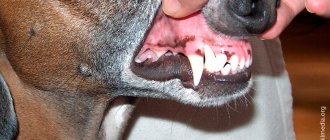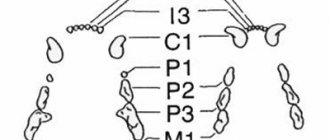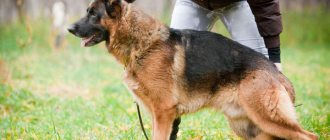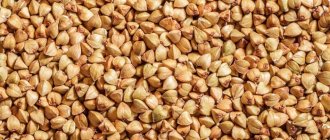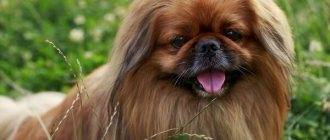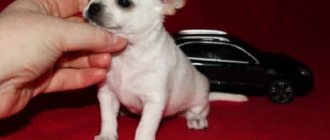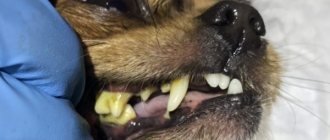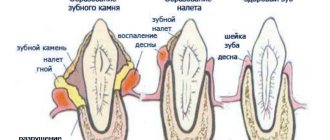In what cases do dogs' teeth become loose and fall out?
The process of unsteadiness and loss can be divided into physiological and pathological. In the first case, there is a change in baby teeth, which actually fall out. You can read more about this here. All other cases of loss, staggering occur due to illness, age-related changes or injury, and are pathological. Why does a dog's teeth fall out?
Bite gaps in dogs under 1 year of age
Before one year of age, the animal’s dental arches are already fully formed. That is, they become what they will be throughout their lives. If any defect is discovered at this time, it is much more difficult to correct it than at the beginning of its occurrence.
Snack
This is a protrusion of the lower jaw relative to the upper. The reasons are varied:
- skull deformation,
- suffered severe injuries,
- genetic failure
- acute mineral deficiency of both the puppy and the mother,
- excessive loads on the puppy’s jaws (sometimes they try to develop a “grip” in the dog from a very early age).
Underbite
The upper jaw extends forward in relation to the lower jaw. The reasons are about the same.
Pincer or level bite
The upper incisors rest against the lower ones, and the mouth does not seem to be completely closed.
Jaw distortion
Displacement of the dental arch relative to the longitudinal axis of the animal’s body.
Oligodontia
Absence of any of the teeth.
Superset
Presence of extra teeth (43 or more). The problem emerges with a delay in shifting and at the age of 1 year the dog has, for example, 2 canines coexisting side by side. One is milky, which did not fall out, and the second is an adult, which continues to grow. There are also teeth in two rows.
At what age is this not normal?
Overbite is a pathology at any age, and the earlier it is diagnosed, the greater the likelihood of its correction. However, it is worth noting that this jaw configuration is not a pathology for breeds such as the German boxer.
Underbite is similarly a pathology from a very early age.
Pincer bite is also always a pathology. Even when correcting an underbite at the stage of transition to a pincer bite. This is an undeniable result, but you shouldn’t stop.
Jaw misalignment is considered pathological. Sometimes it occurs in a mild form in small breeds when the change of teeth is delayed. But with timely intervention it goes away on its own.
Oligodontia at the age of 1 year is a pathology! A very common problem is the absence of the first premolar of the lower jaw, which itself is very poorly developed. This can happen with other teeth.
But if you consider that puppies are born toothless, then during the period of teething up to 7 months, when the molars grow, the absence of some teeth is not a pathology. But a violation of the dental formula at the age of 1 year is a serious problem.
Supernumerary is always a pathology in the formed dental formula.
Important! If the tooth is delayed in replacement, then this is a pathology and is subject to veterinary intervention at 3-7 months. This way the problem will be solved and will not lead to negative consequences of the bite.
Which teeth loosen and fall out most often?
If we talk about age-related changes in the dental formula in dogs and exclude the factor of dental diseases, the presence of a critical amount of tartar, previous injuries, the condition of the gums and other things, then the incisors will wobble and fall out the most. Moreover, in the lower jaw this tendency is much more pronounced. Canines, molars and premolars have much more developed roots, and they sit in the jaws much stronger.
Dental problems in elderly dogs
With proper maintenance and proper care, a dog’s teeth can be in good condition even at the age of 10 years. But if you neglect the simplest rules of dental hygiene and care, the following negative changes will occur.
At the age of 10 years, the teeth will begin to yellow and look extremely unhealthy. Tartar is very developed, sometimes covering the entire tooth. As a result, the gums suffer greatly, they bleed and become inflamed. The dentition loses its reliable fixation and is held in place only by the roots; some begin to wobble. The incisors are oval (ground).
At 10-12 years of age, the incisors are critically worn out and begin to fall out, plus all the problems listed above.
At what age do dogs lose their teeth? At the age of 16, old dogs usually lose their incisors and the rest come next.
Important! Everything is individual and with proper maintenance, some dogs have excellent dental formula even at 16 years old (for example, a male German Shepherd - black “Akbar”).
Do all dogs lose their teeth the same way?
The trend in this direction is the same as during eruption, change and formation of the adult dental formula. Small breeds are much more susceptible to such problems and risks. Especially with extreme faces. But loss is relevant for all breeds and for various reasons.
Medium and large breeds
If the maintenance and care of pets were adequate, then teeth fall out mainly due to age-related changes. Most often this happens to incisors aged 10 years or older. The incisors of the lower jaw are more susceptible. But if the dog has advanced tartar, a chronic form of stomatitis or gingivitis, then there will be problems with the rest.
Anatomically, the tooth root in such breeds is very well developed. Good fixation in the jaw holds the tooth in place by itself. But the pathological factors listed above can destroy this mechanism. Good nutrition and oral hygiene prolongs the health of the oral cavity and dentition.
Small dogs
Tooth loss in small breed dogs is common. Dogs, especially those with a flattened muzzle, are naturally susceptible to a number of dental problems:
- lack of teeth,
- predisposition to tartar,
- delay in changing teeth, etc.
The jaws themselves are very small, and the roots of the teeth are quite weak. Plus genetic predisposition. Often teeth begin to fall out at 2-3 years in individuals along the same ancestral line. Often, poor nutrition (feeding sausage, snacks, sweets), even in small quantities, leads to loosening and subsequent loss. The process is enhanced by the fact that in small dogs it is very difficult to use therapeutic splints and bite correctors.
Signs of a healthy grin
A complete bite is represented by a set of 42 teeth. Deviations in quantity, up or down, are a pathology of genetic development. Twenty-two pieces are located on the lower jaw and another 20 on the upper jaw.
In puppies, the enamel color is white, but in adults it gradually turns yellowish - this is normal. Bite development is determined according to breed standards. A sign of a correct grin is considered to be moderate grinding of the teeth, which does not interfere with eating.
Large dog breeds, such as Rottweilers and Shepherds, often grow a pair of extra canines. This is recognized as the norm. Short-faced dogs have a lack of teeth, which is not a defect.
Why do gaps appear in the teeth?
Why does a dog's teeth fall out? The reasons are varied and can be divided into the following groups:
- genetic, inherited;
- resulting from severe metabolic disorders;
- acquired after injury.
Diseases in which there is a high risk of tooth loss
Most often this happens with highly developed tartar. It affects both the tooth itself and the gum that holds it. Damage to the gums turns into gingivitis, and if the course is negative, periodontitis occurs - tooth destruction.
The stone begins to form from the so-called biofilm. It consists of colonies of various bacteria, fungi, fusobacteria, and spirochetes. This is where the unpleasant smell comes from. It can lead to necrotic changes in the jaw. Gingivitis can also be caused by:
- malnutrition,
- acute microelementosis,
- immunosuppressive conditions,
- heavy metal poisoning,
- bite pathologies,
- nasal breathing disorder,
- diabetes.
Internal diseases leading to hair loss
These are all internal diseases that cause immune suppression, for example:
- rheumatoid arthritis,
- diabetes,
- osteoporosis.
Causes not related to disease
This should include:
- heavy metal poisoning,
- the effect of ionizing radiation,
- severe maxillofacial injuries.
The effect of changing teeth on a puppy's health
When baby teeth are replaced with permanent ones, the animal's immunity weakens. During this period, sudden changes in body temperature pose a particular threat to his health: hypothermia and overheating, which means that the duration of walks must be minimized, especially in the cold months.
It is also better to postpone intense training for a while.
Expert opinion
Anna Abramenko
An avid dog lover. Experience in veterinary medicine since 2009.
Ask a Question
To minimize the risk of disease, all necessary vaccinations are given to the pet before its body begins to rebuild.
Symptoms that precede tooth loss in dogs
Initially, a light plaque appears on the tooth - biofilm. Then - a characteristic unpleasant smell. The smell intensifies as tartar develops. The stone begins to irritate the gums, they become inflamed and gingivitis occurs. There are many different forms of gingivitis, but they are all similar, ranging from simple inflammation to ulcers. Discharge and blood may appear, and in severe cases, periodontitis may develop. The teeth begin to loosen. There were cases when not one, but several adjacent teeth were held together only by a huge solid tartar. When I tried to clean the stone, it fell off along with my teeth. This is followed by destructive changes in the gums, the tooth itself and the jaw in particular. Pus begins to come out.
Diagnosis and correction of the situation
Important! At the first symptoms, we contact a veterinarian. Early diagnosis gives a high chance of correcting a particular defect.
You can remove the biofilm yourself using special pastes, brushes or a gauze pad soaked in peroxide. It is visible to the naked eye. This will also eliminate the smell.
The stone should be removed by a specialist; anesthesia may be used.
If gingivitis was detected at an early stage, then basic oral hygiene, rinsing with oak bark, sage, chamomile, etc. can help. Oral antiseptics or chlorhexidine can be used.
For severe gingivitis use:
- novocaine blockades with antibiotics,
- washing with furatsilin,
- X-rays may be required
- surgical intervention is possible.
Periodontitis is treated by removing part of the damaged tooth or removing it completely. Drug treatment helps only in the very early stages of the development of this disease.
My dog has a loose tooth, what should I do? If a loose permanent tooth is identified, contact the clinic. It is possible to save him. You can get by with medicinal treatment of the gums. It is important to relieve inflammation from the gums and remove its cause. Antibiotics and antiseptics will help.
Nutrition is adjusted, special medications are used, for example, Tsamax with Spirulina. In critical cases, tires made of stainless wire and special fiberglass are used. A splint is being built that holds several teeth, including loose teeth.
In case of necrotic damage to the teeth, gums, or jaw, the dead areas are removed and strong antibiotic therapy is prescribed. Washing with furatsilin, chlorhexidine and maintenance therapy are required.
Basic treatment methods
My dog's teeth are falling out, what should I do? In this case, the dog needs the therapeutic help of a specialist. The reason for the development of the process should be established. Possible treatment options are based on your medical history. We must remember that biofilm is the precursor to all further complications. Identifying and treating tartar is the first step. For severe forms of gingivitis, antibiotics are used. At earlier stages, novocaine blockades and antiseptics are used.
It is important to exclude possible internal diseases that contribute to tooth loss. Make sure there is no poisoning with heavy metals or damage from ionizing radiation. For purulent processes, it is recommended to conduct an antibiotic sensitivity test. An x-ray is required.
Often it comes down to surgery to remove a tooth or affected area of gum or bone tissue. The likelihood of prosthetics is very high. Oral splints based on stainless wire and special fiberglass have proven themselves very well.
What to do for prevention?
Measures:
- Regular oral examinations, especially if you are the owner of a small dog.
- If problems arise (bleeding and inflammation of the gums, loose or irregular teeth), contact your veterinarian immediately.
- Clean your teeth daily or at least weekly.
- Examination of the oral cavity by a specialist at least 3-4 times a year.
- Nutrition should be balanced.
- Give your dog chew bones, etc., to strengthen your pet's jaws.
What are the risks of tooth loss for your pet?
The loss of several chewing elements can have serious consequences for the health of the animal. Poorly chewed food can cause problems in the gastrointestinal tract. While chewing, your pet may experience pain, bleeding gums, and deterioration in general condition. As a result of the increased load on the remaining teeth, the bite may be disrupted and the dentition may wear out faster. Such dogs cannot take part in animal shows, since one of the conditions for participation is the presence of all teeth.
